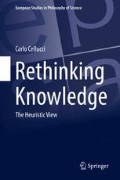Abstract
The distinction between axiomatic demonstration and analytic demonstration provides a basis for dealing with the question of mathematical explanations. One may speak of mathematical explanations in two different senses: mathematical explanations of mathematical facts and mathematical explanations of empirical facts. This chapter mainly deals with mathematical explanations of mathematical facts. It argues that there is an objective distinction between explanatory and non-explanatory demonstrations, and distinguishes between two different approaches to explanatory demonstrations: the static approach, based on axiomatic demonstration, and the dynamic approach, based on analytic demonstration. The chapter maintains that explanatory demonstrations in the static approach are intended to convince the audience that a proposition should be accepted, while explanatory demonstrations in the dynamic approach are intended to reveal how the demonstration was discovered. The chapter also deals with mathematical explanations of empirical facts, maintaining that it is unjustified to claim that there are such explanations.
Access this chapter
Tax calculation will be finalised at checkout
Purchases are for personal use only
References
Atiyah, Michael. 1984. Interview by Roberto Minio. The Mathematical Intelligencer 6 (1): 9–19.
Baker, Alan. 2005. Are there genuine mathematical explanations of physical phenomena? Mind 114: 223–238.
———. 2009. Mathematical explanation in science. The British Journal for the Philosophy of Science 60: 611–633.
Baker, Alan, and Mark Colyvan. 2011. Indexing and mathematical explanation. Philosophia Mathematica 19: 323–334.
Colyvan, Mark. 2013. An introduction to the philosophy of mathematics. Cambridge: Cambridge University Press.
Daly, Christopher, and Simon Langford. 2009. Mathematical explanation and indispensability arguments. The Philosophical Quarterly 59: 641–658.
Descartes, René. 1996. Oeuvres. Paris: Vrin.
Devlin, Keith. 1990. Mathematics: The new golden age. London: Penguin Books.
Gowers, Timothy. 2007. Mathematics, memory and mental arithmetic. In Mathematical knowledge, ed. by Mary Leng, Alexander Paseau, and Michael Potter, 33–58. Oxford: Oxford University Press.
Gowers, Timothy, and Michael Nielsen. 2009. Massively collaborative mathematics. Nature 461(15 October): 879–881.
Hardy, Godfrey Harold. 1929. Mathematical proof. Mind 38: 1–25.
Hempel, Carl Gustav, and Paul Oppenheim. 1948. Studies in the logic of explanation. Philosophy of Science 15: 135–175.
Hersh, Reuben. 1997. What is mathematic, really? Oxford: Oxford University Press.
———. 2014. Experiencing mathematics: What do we do, when we do mathematics? Providence: American Mathematical Society.
Huntley, H.E. 1970. The divine proportion: A study of mathematical beauty. Mineola: Dover.
Karihaloo, Bhushan, K. Zhang, and J. Wang. 2013. Honeybee combs: How the circular cells transform into rounded hexagons. Journal of the Royal Society Interface 10 (86). doi:10.1098/rsif.2013.0299.
Kitcher, Philip. 1983. The nature of mathematical knowledge. Oxford: Oxford University.
———. 1991. Persuasion. In Persuading science: The art of scientific rhetoric, eds. Marcello Pera and William Shea, 3–27. Sagamore Beach: Science History Publications.
Krantz, Steven G. 2011. The proof is in the pudding: The changing nature of mathematical proof. New York: Springer.
Lange, Marc. 2013. What makes a scientific explanation distinctively mathematical? The British Journal for the Philosophy of Science 64: 485–511.
Lyon, Aidan, and Mark Colyvan. 2008. The explanatory power of phase spaces. Philosophia Mathematica 16: 227–243.
Mancosu, Paolo. 2008. Introduction. In The philosophy of mathematical practice, ed. Paolo Mancosu, 1–21. Oxford: Oxford University Press.
Maslow, Abraham H. 1966. The psychology of science: A reconnaissance. New York: Harper & Row.
Pappus. 1876–1878. Collectio. Berlin: Weidmann.
Pincock, Christopher. 2007. A role for mathematics in the physical sciences. Noûs 41: 253–275.
———. 2012. Mathematics and scientific representation. Oxford: Oxford University Press.
Poincaré, Henri. 2013. The foundations of science: Science and hypothesis – The value of science – Science and method. Cambridge: Cambridge University Press.
Popper, Karl Raimund. 1959. The logic of scientific discovery. London: Hutchinson.
Resnik, Michael David, and David Kushner. 1987. Explanation, independence and realism in mathematics. British Journal for the Philosophy of Science 38: 141–158.
Sierpinska, Anna. 1994. Understanding in mathematics. London: The Falmer Press.
Spitz, Ellen Handler. 1994. Museums of the mind: Magritte’s labyrinth and other essays in the arts. New Haven: Yale University Press.
Tóth, László Fejes. 1964. What the bees know and what they do not know. Bulletin of the American Mathematical Society 70: 468–481.
van Fraassen, Bas. 1980. The scientific image. Oxford: Oxford University Press.
Weyl, Hermann. 1985. Axiomatic versus constructive procedures in mathematics. The Mathematical Intelligencer 7 (4): 10–17, 38.
Wittgenstein, Ludwig. 1958. Philosophical investigations. Oxford: Blackwell.
———. 1978. Remarks on the foundations of mathematics. Oxford: Blackwell.
Zimecki, Michał. 2006. The lunar cycle: Effects on human and animal behavior and physiology. Postępy Higieny i Medycyny Doświadczalnej 60: 1–7.
Zukav, Gary. 1980. The dancing Wu Li Masters: An overview of the new physics. New York: Bantam Books.
Author information
Authors and Affiliations
Rights and permissions
Copyright information
© 2017 Springer International Publishing AG
About this chapter
Cite this chapter
Cellucci, C. (2017). Mathematical Explanations. In: Rethinking Knowledge. European Studies in Philosophy of Science, vol 4. Springer, Cham. https://doi.org/10.1007/978-3-319-53237-0_22
Download citation
DOI: https://doi.org/10.1007/978-3-319-53237-0_22
Published:
Publisher Name: Springer, Cham
Print ISBN: 978-3-319-53236-3
Online ISBN: 978-3-319-53237-0
eBook Packages: Religion and PhilosophyPhilosophy and Religion (R0)

